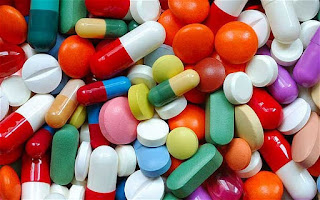Dexamethasone
Trade name: dexacort
Class: adrenocorticosteroid
–synthetic, glucocorticoid type Pregnancy: (Category C/D if used in 1st
trimester)
Action:
• They are a group of natural hormones produced by the adrenal
cortex.
• They are used for a variety of therapeutic purposes.
• Many slightly modified synthetic variants are available today.
• Some patients respond better to one substance than to another.
• These hormones influence many metabolic pathways & all organ
systems & are essential for survival.
• The
release of corticosteroids is controlled by hormones such as corticotropin-
releasing factor produced by the hypothalamus & ACTH produced by the
anterior pituitary.
Uses:
• Replacement therapy: adrenal
insufficiency (Addison’s disease) .
• Rheumatic disorders: rheumatoid
arthritis & osteoarthritis.
• Collagen diseases: systemic
lapus erythematosus, rheumatic cardiac.
• Allergic diseases: drug
hypersensitivity, urticarial transfusion reaction.
• Respiratory diseases: bronchial
asthma, rhinitis.
•
Ocular
diseases : allergic & inflammatory conjunctivitis, keratitis … Dermatological
diseases: psoriasis, contact dermatitis, urticaria.
• Diseases of the GIT: ulcerative
colitis.
• Nervous system: Myasthenia
gravis.
• Malignancies: leukemia,
lymphoma.
• Nephrotic syndrome.
• Hematologic diseases: hemolytic
anemia, thrombocytopenic purpura.
Miscellaneous: septic shock, liver
cirrhosis, stimulation of surfactant
Production, prevention of organ rejection.
Dose
By mouth, usual
range 0.5–10 mg daily;
by intramuscular
injection or slow intravenous injection or infusion (as
dexamethasone phosphate), initially 0.5–20 mg; CHILD
200–500 micrograms/kg daily
Cerebral edema (as dexamethasone phosphate), by
intravenous
injection, 10 mg initially, then 4 mg by intramuscular injection every 6
hours as required for 2–10 days
Shock
(as dexamethasone phosphate), by intravenous injection or infusion, 2–
6 mg/kg, repeated if necessary after 2–6 hours
Note. Dexamethasone 1 mg = dexamethasone phosphate
1.2 mg = dexamethasone sodium phosphate 1.3 mg Contraindications:
• If infection is suspected (Mask signs & symptoms).
• Peptic ulcer.
• Acute glomerulonephritis.
• Cushing’s syndrome.
• Congestive
heart failure.
• Hypertension.
• Hyperlipidemia.
Side effects:
• Edema, alkalosis, hypokalemia, hypertension, CHF muscle wasting,
weakness, osteoporosis, nausea & vomiting.
• Headache, hypercholesterolemia, hirsutism, amenorrhea,
depression.
• Redistribution of body fats: thin extremities and fat trunk,
moon-like face, buffalo hump.
Nursing
considerations:
§ Administer oral forms with food to minimize ulcerogenic effect.
§ For chronic use, give the smallest dose possible.
§ Corticosteroids should be discontinued gradually if used
chronically.
§ Document baseline weight, B.P., Pulse & temperature.
§ Frequently take BP, monitor body weight (signs of Na+ & H2O
retention).
§ Periodic serum electrolytes, blood sugar monitoring.
§ Report signs & symptoms of side effects (Cushing-like
syndrome).
§ Discuss with female client potentials of menstrual difficulties.
§ Instruct the client to take diet high in protein &
potassium.
§ Instruct the client to avoid falls & accidents (osteoporosis
causes § Pathological fracture).
§ Remind the client to carry a card identifying the drug being
used.
§ Stress the need for regular medical supervision.
§ Advice the client to delay any vaccination while taking these
medications (Weakened immunity).
§ Explain the need to maintain general hygiene & cleanliness
to prevent Infection.



